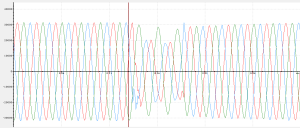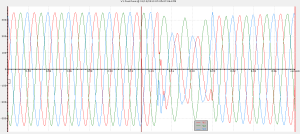Another transmission level (230kV) fault happened earlier at 19:05 hrs.
Places in the Western area would have seen the worst dip magnitudes /duration ( ~ 50% dip by)
* Will update with a waveform from one of our PQ monitors in the West soon.
Till then; Happy 2014 ! (in advance)
Update: 2/1/2014
From the following waveforms, we can conclude that there was a 230kV single phase fault on Phase L1 (red)
Voltage Dip Waveform Captured In the West (22kV) – Dip by 40.83%, 78ms

Voltage Dip Waveform Captured In the West (Low Voltage-230V) – Dip by 43%, 80ms

Notes:
A transmission level fault will cause an islandwide voltage dip.
Here, in Singapore. a voltage dip is defined as a drop of more than 10% of the nominal voltage (Line voltage). It typically lasts around 200ms.
In Singapore, the transmission network consists of a 400kV network, overlayed onto 4 x 230kV blocks. The 230kV blocks were split up in the mid 2000s, for controlling of fault level.
It has inherently brought an advantage: Minimize the impact of a voltage dip due to a 230kV transmission fault to just that particular block.
Hence in a 230kV fault, only connected customers in that particular block which the fault occurred will ‘see’ severe dip values (usually in the ranges of 40-50% dip by magnitude for single phase 230kV faults); Customers in the lower voltage levels (66kV, 22kV…) of that block will see similar (as seen at 230kV) dip severity or less (slightly).
The other 3 blocks will see significantly less severe voltage dip or just a slight variation of the nominal voltage.